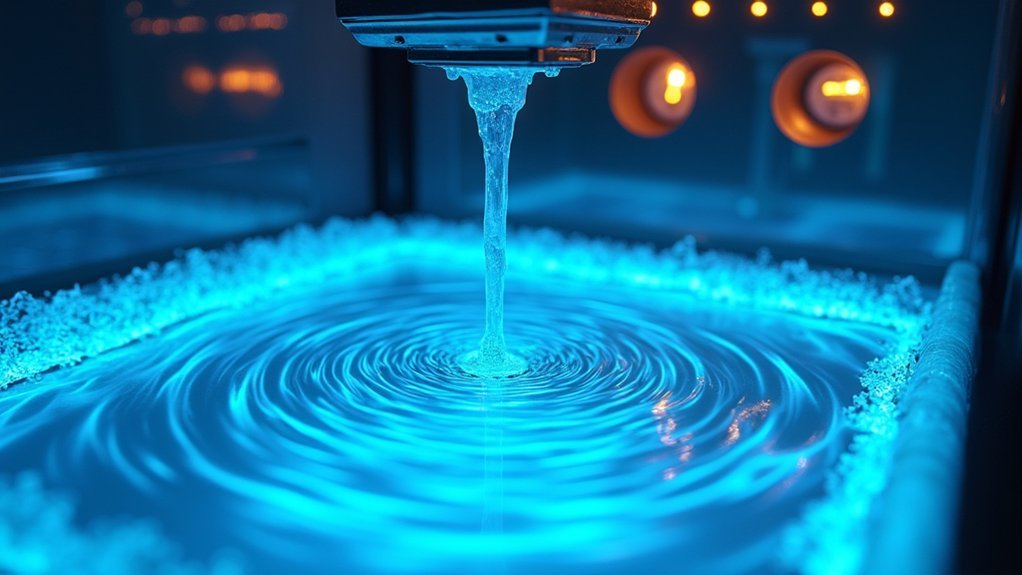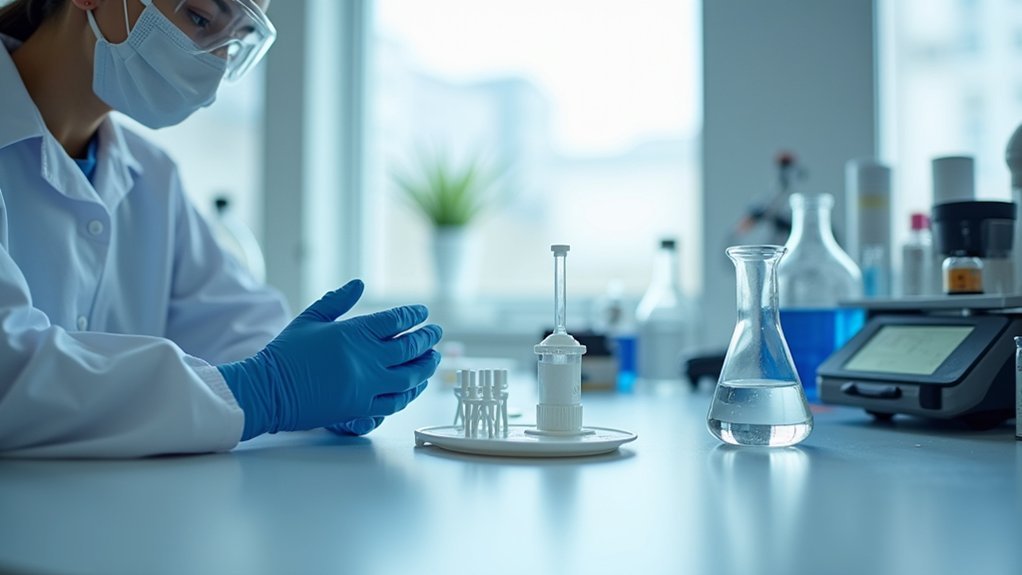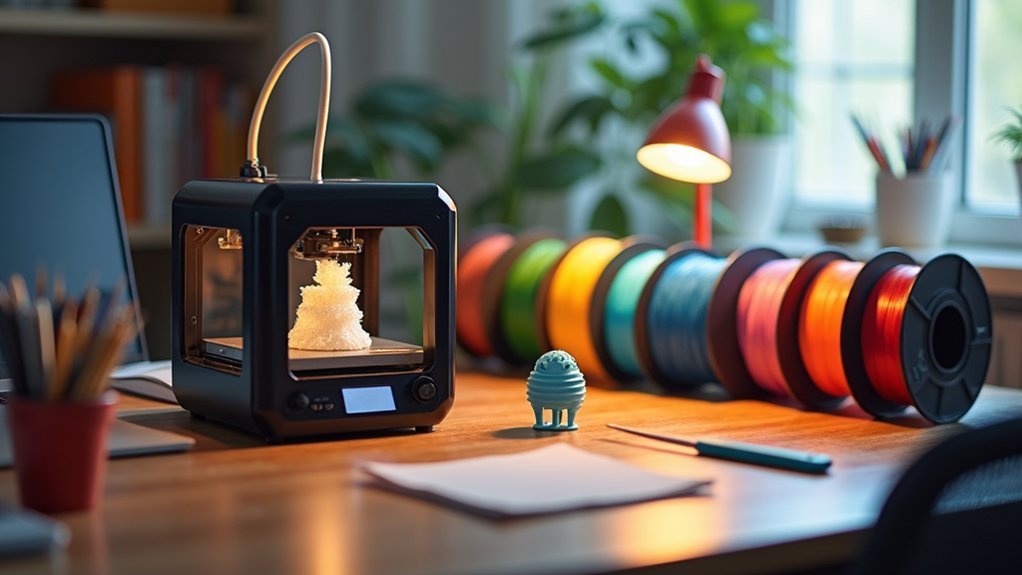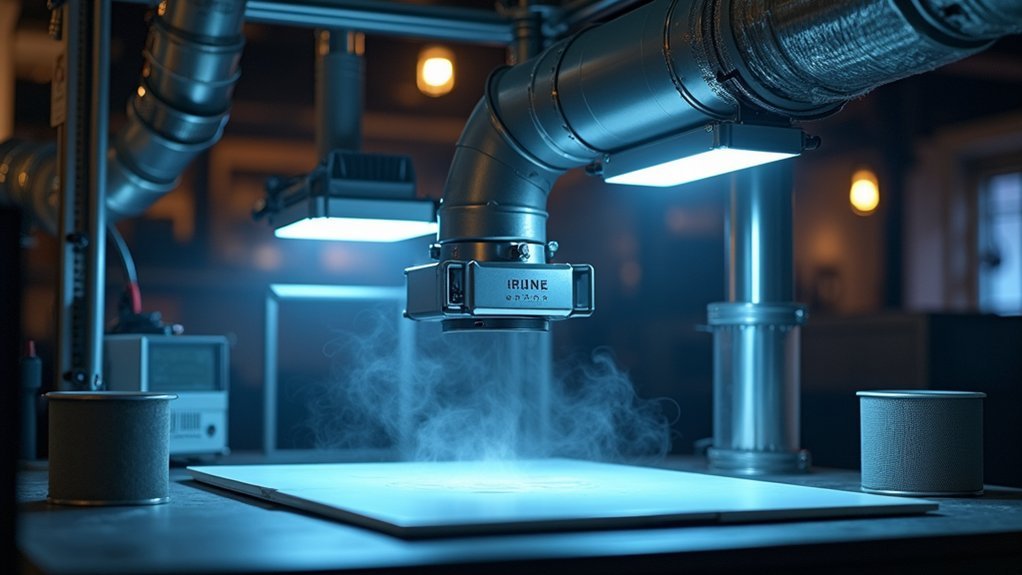You’ll get the best results dissolving 3D print supports using chemical dissolution tanks with continuous circulation, which prevents solvent saturation and speeds removal. For delicate parts, ultrasonic systems create gentle microscopic bubbles that won’t damage intricate features. High-temperature processing at 90°C for ABS or 60°C for PETG accelerates breakdown considerably. DIY setups with stainless steel tanks and aquarium pumps offer cost-effective solutions. Always wear chemical-resistant gloves and guarantee proper ventilation when handling heated solvents to maximize both efficiency and safety throughout your workflow.
Chemical Dissolution Tanks With Continuous Circulation

With chemical dissolution tanks featuring continuous circulation, you’ll achieve faster and more efficient support removal through constant solvent movement.
These systems use pumps to maintain ongoing solvent flow, preventing saturation around your parts and expediting the dissolution process. You’ll need tanks larger than your maximum part size to accommodate multiple pieces while minimizing saturation risk.
The continuous circulation replaces saturated liquid with fresh solvent, accelerating support material breakdown.
Fresh solvent circulation prevents saturation buildup, dramatically improving dissolution efficiency and reducing processing time for support material removal.
Most chemical dissolution tanks feature stainless steel construction to withstand high pH levels from alkaline solvents, guaranteeing durability throughout the process.
You’ll need to regularly maintain and monitor the pump system to prevent clogs from dissolved support slurry.
This maintenance guarantees peak operation and extends your equipment’s longevity while maintaining consistent support removal performance.
Ultrasonic Support Removal Systems
Ultrasonic support removal systems harness high-frequency sound waves to create microscopic bubbles in solvent that gently detach support materials from your 3D printed parts.
The bubble agitation penetrates tight spaces in intricate designs, ensuring thorough support material removal without damaging delicate features. This makes ultrasonic support removal systems perfect for fragile models that can’t withstand aggressive removal methods.
You’ll notice these tanks operate noisily, but soundproofing reduces the disturbance.
Processing times are longer than other methods, making them less suitable for high-volume industrial applications.
Regular maintenance is essential—you must clean the system and monitor solvent quality to maintain effectiveness.
Despite longer processing times, the gentle nature of ultrasonic cleaning provides superior results for complex printed parts requiring careful handling.
High-Temperature Solvent Processing

High-temperature solvent processing accelerates support material dissolution by heating solvents to suitable temperatures that break down plastic bonds more rapidly than room-temperature methods.
You’ll achieve best results heating solvents to 90°C for ABS parts and 60°C for PETG materials.
Use a tank larger than your maximum part size to accommodate multiple pieces and prevent solvent saturation.
Add agitation through pumps or propellers to replace saturated liquid around supports, enhancing dissolution efficiency.
Monitor and maintain consistent temperatures to guarantee proper dissolution rates without damaging your prints.
Wear gloves and wear safety glasses during high-temperature solvent processing to prevent burns from heated solutions.
Ensure proper ventilation to avoid inhaling harmful fumes while processing your parts.
DIY Support Dissolution Setups
Building your own support dissolution setup saves money while giving you complete control over the process parameters.
You’ll need a heat-resistant stainless steel tank that withstands high temperatures while dissolving support structures from complex parts. Install a temperature regulator to maintain stable solvent temperatures—90°C for ABS and 60°C for PETG to prevent print deformation.
An aquarium pump provides essential agitation by circulating solvent, though harsh chemicals may reduce its lifespan. Alternatively, a sous-vide stick serves dual purposes as both heater and agitator, offering cost-effective temperature control and solvent movement.
Replace fluids after several cycles and always wear safety gear including gloves and goggles. A heat gun can assist with stubborn support removal before chemical processing.
Safety Equipment and Best Practices for Solvent Handling

While working with solvents can streamline your support removal process, you’ll need proper safety measures to protect yourself from chemical burns, toxic fumes, and heat-related injuries.
Essential safety gear includes chemical-resistant gloves and safety glasses to shield against splashes and sharp edges during removal. Establish proper ventilation in your workspace to prevent inhaling dangerous fumes that accumulate in enclosed areas.
Use closed-circuit tank systems to minimize exposure to heated liquids and reduce burn risks. Replace solvents regularly after multiple cycles to maintain their effectiveness and guarantee safe handling.
When working with heated solutions, utilize heat-resistant tools and equipment exclusively. These solvent handling protocols aren’t just recommendations—they’re critical for preventing serious injuries while achieving professional support removal results.
Frequently Asked Questions
How Do You Dissolve 3D Print Supports?
You’ll match your solvent to the support material—water for PVA, alkaline solutions for HIPS. Maintain proper temperatures, use agitation methods like pumps, and replace solvents regularly for effective dissolution.
What Is the Best Tool to Remove Supports From 3D Print?
You’ll find a wide standard screwdriver most effective for prying off supports, providing excellent leverage. Combine it with high-quality snips for cutting excess material and stainless steel picks for detailed work.
How Do You Unglue 3D Printed Parts?
You’ll apply compatible solvents like acetone for ABS or isopropyl alcohol for PLA. Use gentle heat, carefully pry with a razor blade, or soak cyanoacrylate bonds in warm soapy water while wearing protective gear.
How to Dissolve PVA Supports?
You’ll dissolve PVA supports by soaking them in warm water at 60-70°C. Use gentle agitation like stirring to speed dissolution. Let parts soak for several hours, checking periodically until supports completely disappear.





Leave a Reply